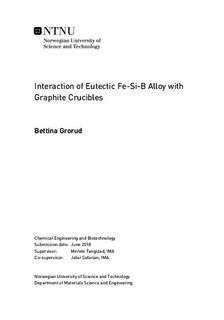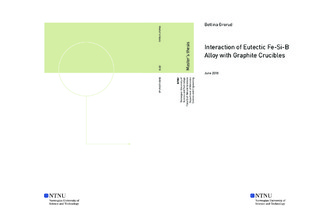| dc.description.abstract | The work in this thesis was performed as a part of the AMADEUS project. The goal was to experimentally investigate the interaction between eutectic Fe-Si-B alloy and dense graphite crucibles, and the results will be compared to previous work performed by the author (2017) on eutectic Si-B alloy. The results will be used to ultimately decide if eutectic Fe-Si-B alloy in graphite crucibles is suitable for application in latent heat thermal energy storage (LHTES) systems. The experiments were performed on eutectic Fe-Si-B alloy with a composition of 64 wt.% Fe,26 wt.% Si, and 9 wt.% B, contained in dense graphite crucibles. The experimental work wasconducted in a resistance heated furnace in 5N Ar (g) atmosphere, in which three different typesof experiments were performed:
The samples were subjected to 20 °C above the melting temperature for 1 h, before one or two temperature cycles between Tm ± 20 °C were initiated.
The samples were subjected to 1550 °C for 1 h, before one or two temperature cycles between Tm ± 20 °C were initiated.
The samples were subjected to 1550 °C for 1 h, before one temperature cycle between Tm ± 100 °C was initiated.
The characterisation of the samples was mainly performed by light optical microscopy (LOM), scanning electron microscopy (SEM), and electron probe micro-analyser (EPMA). Wetting tests of Fe-Si-B alloy on graphite and alumina were also performed.
It was found that very little silicon had penetrated into the crucible to form SiC, while significant penetration was observed in the previous work performed by the author. This indicates that eutectic Fe-Si-B has a lower degrading effect on the crucible compared to eutectic Si-B alloy, which is desirable for the intended application.
No continuous SiC barrier layer was observed in any of the samples containing Fe-Si-B alloy. Some single SiC and B4C particles were observed along the edges of the alloy, in addition to a eutectic B(4+delta)C phase in several areas of the alloy. The total amount of carbon present in the eutectic Fe-Si-B alloy still appeared to be lower compared to eutectic Si-B alloy, and it can thus be assumed that the Fe-Si-B alloy will remain more stable with time compared to the Si-Balloy.
The wettability of the Fe-Si-B alloy on graphite was found to be high, with a measured contact angle of approx. 30°. High wettability might result in more penetration of silicon in the crucible, and consequently faster degradation of the crucible. However, since very little penetration of silicon was observed in the crucible, the high wettability will most likely not be a challenge in the intended application.
The wettability of the Fe-Si-B alloy on alumina was found to be low, with measured contact angles of approx. 120°. This, in addition to low reactivity between the materials, indicates that alumina might be a possible alternative crucible material for eutectic Fe-Si-B alloy in the intended application.
Unlike the Si-B alloy, the volume of the Fe-Si-B alloy was found to be shrinking during solidification. This is a desirable material property for the intended application due to previous challenges caused by volume expansion during solidification of the alloy.
Five different phases were identified by EPMA analysis. This includes FeB and Si4BFe4 as matrices, SiB6 and Si2B5Fe2 as eutectic phases, and SiC particles located at the edge of the samples. It is uncertain if the two three-component phases, Si4BFe4 and Si2B5Fe2, were metastable or if they were stable due to carbon saturation of the system. Two modifications of boron carbide were found, namely B4C and B(4+delta)C. B4C was formed as particles in the same areas as SiC, while B(4+delta)C appeared to be a eutectic phase. The B(4+delta)C was found to contain more boron compared to B4C, in addition to slightly more aluminium impurities.
The fusion enthalpy of Fe-Si-B with 64 wt.% Fe, 26 wt.% Si, and 9 wt.% B was calculated in FactSage to be 3.67 kJ/cm3. This is slightly lower than for eutectic Si-B, which has a fusion enthalpy of 4.42 kJ/cm3, but still sufficiently high for the intended application. The samples in the wetting tests showed signs of melting in the range between 1200-1250 °C, and the slight deviation from the theoretical melting temperature is considered to be due to carbon saturation.
The obtained composition of the master alloy was confirmed to be close to the ideal compositionby ICP-MS analysis. Other than the alloying elements, only very small concentrations of Al and Mn were detected. The results obtained in this work are thus considered to be representative for eutectic Fe-Si-B alloy with a composition of 64 wt.% Fe, 26 wt.%Si, and 9 wt.% B.
The overall results indicate that eutectic Fe-Si-B alloy with the composition of 64 wt.% Fe, 26 wt.% Si, and 9 wt.% B is highly suitable for the application as phase change material in latent heat thermal energy storage (LHTES) systems. The results also indicate that alumina might be a possible alternative crucible material for the intended application. | |

